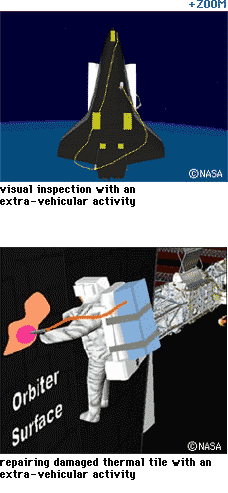 |
 |
 In future flights, the following capabilities will be required: 1) inspection of Shuttle's body while in orbit, 2) checking for damage on the TPS such as RCC panels and tiles, 3) evaluation of the critical nature of any damage found, 4) making repairs of critical damage with EVA and robotics. In future flights, the following capabilities will be required: 1) inspection of Shuttle's body while in orbit, 2) checking for damage on the TPS such as RCC panels and tiles, 3) evaluation of the critical nature of any damage found, 4) making repairs of critical damage with EVA and robotics.
Since astronauts will be the ones conducting such repairs, our opinions play an integral part in the discussions, evaluations, and development of these capabilities. More than ten astronauts, including myself, have been participating in this process. We have been working with many people including those in the Space Shuttle Program Office, engineering departments, and manufacturing contractors for the development of the TPS inspection boom. The 15-meter inspection boom, equipped with a laser device and a camera, will be attached to the end of the Shuttle's robotic arm for TPS inspections. Also, an astronaut can be attached to the end of the boom to conduct a visual inspection during an EVA.
Using my previous experience as a robotic arm operator, I have had an opportunity to make recommendations on issues such as where to attach the cameras so that we can move the boom safely without damaging the Shuttle or the International Space Station (ISS). Astronauts have been using simulators to evaluate the safety and the operability of the TPS inspection boom. Usually, a group of astronauts participates in these evaluations, and according to the results of the evaluations, we come to a consensus in the Astronaut Office and provide recommendations to the designers.
In addition, we are helping to develop the repair materials and tools for TPS repairs, which will be conducted by EVA. In the development process, we use a variety of facilities including a special water tank whose neutral buoyancy can simulate a weightless environment for an astronaut wearing an EVA suit, a KC-135 aircraft, which in a parabolic flight can create a state of microgravity for approximately 25 seconds, and a chamber which can simulate the thermal and vacuum environment in space. Astronaut Soichi Noguchi of JAXA, who will conduct EVAs on the return to flight mission, has been playing an important role in the development. |
 |
2/4 |
 |
|
 |
 |